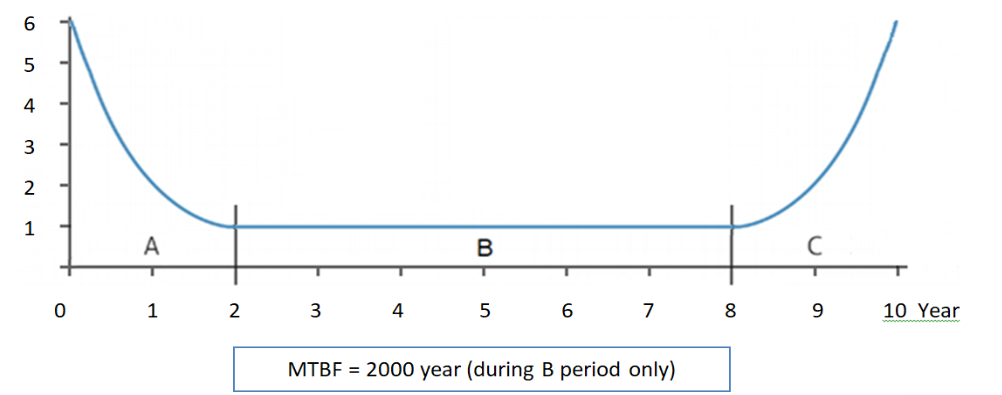Reliabaility, failure rate and MTBF
About MTBF
MTBF, or Mean Time Between Failures, is a measure of how reliable a battery (or any device) is. For batteries, MTBF represents the average time expected between failures during normal operation.
For example,
If a battery has an MTBF of 2000 years, it doesn’t mean an individual battery will last that long. Instead it means that if you had 2000 identical batteries, statistically, one would fail each year.
While MTBF gives a good sense of reliability, battery lifespan is also influenced by factors like temperature, charge cycles, and maintenance. Regular monitoring helps catch failing cells early, extending the overall system’s life.

Failure rate and reliability
In the image, we see the bathtub curve, which illustrates the failure rate over the lifetime of a battery. The battery progresses through phases A, B, and C — ending in phase C, where the battery’s life gradually comes to an end and replacement becomes necessary.
Storage conditions have a significant impact on battery lifespan, while monitoring plays a crucial role in ensuring reliability.
- Section A: In section A, a newly installed battery undergoes an initial period during which the risk of failure is particularly high. During this time, issues may arise due to manufacturing defects, transportation damage, or improper handling of the battery, leading to internal defects. Monitoring each cell in the battery is crucial to detect potential issues early and replace faulty blocks, thereby ensuring long-term battery lifespan and reliability.
- Section B: (between 2 to 8 years), batteries typically experience a stable period of performance. During this time, the battery’s capacity remains relatively consistent, and it continues to function effectively, assuming it is properly maintained. The degradation is minimal, and most batteries can still perform at a reliable level without significant loss of charge or power. This period represents the optimal phase for battery performance, where they deliver consistent energy output, provided they are not exposed to extreme temperatures or improper usage. Regular maintenance and monitoring can help extend this stable phase.
- Section C: (between 8 to 10 years), batteries begin to show signs of wear and gradual degradation. During this period, the battery’s capacity starts to decline more noticeably, and it may struggle to hold a full charge. Efficiency decreases as the chemical reactions within the battery slow down, leading to reduced performance. While many batteries can still function, they may experience shorter usage times, longer charging cycles, and potential issues with reliability. Proper care and monitoring become even more critical to prevent premature failure, and replacement may be necessary as the battery nears the end of its lifespan.

In the picture above, we don’t have Batscan monitoring, therefore we don’t see the Battery faults (in red text) adding up every year.
The curve shown—shaped like a bathtub—illustrates the number of new battery faults per year. As seen in the graph, the system starts with around 6 random faults, and over time, an additional 1–2 faults occur each year, gradually accumulating.
It’s important to understand that a single faulty battery block can cause an entire string to fail. In a UPS setup with multiple battery strings, faults can occur randomly across any of them. For example, if there are 6 strings and each one contains just one faulty block, the entire UPS system may fail to deliver power during a critical event—defeating the very purpose of having a UPS in the first place.
The UPS’s built-in monitoring/detecting system measures only the total voltage across the entire battery system—using just two measurement points: positive and negative. This approach is not sufficient for ensuring a reliable UPS system that performs when it’s truly needed.
By the time changes in total voltage are detected, the underlying battery faults have already occurred. If a power outage happens at that stage, the risk of system failure becomes significantly higher— resulting in serious consequences, putting the facility in danger both in terms of safety and operational costs. Read more about built in monitoring for the UPS
Without Batscan monitoring
For your batteries, you can’t accurately identify which ones are failing. As a result, faulty batteries often go unnoticed and continue to degrade. They silently contribute to the overall failure of the battery system. Over time, this buildup of weak or damaged batteries can reduce the reliability of your UPS. It may cause unexpected power interruptions, lower performance, and costly system failures. Regular monitoring helps detect failing batteries early. This allows for timely replacements and preserves the integrity and dependability of your UPS.

Replacing all the batteries after just three years may seem like a solution, but it often reintroduces early-life issues. These are the initial problems that occur during a battery’s first phase. At this stage, the batteries are continuously undergoing the early settling period, where they are still stabilizing and adjusting. Replacing all the batteries after just three years creates a repeating cycle. This prevents the system from reaching its optimal performance phase. The constant turnover leads to ongoing issues with stability, capacity, and reliability. The batteries are replaced before they can reach their full potential. To avoid these recurring problems, it’s essential to properly monitor battery health and replace them only when necessary.

